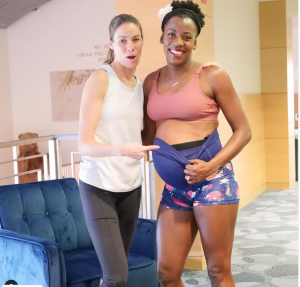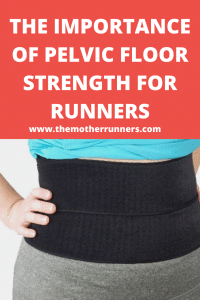Celeste Goodson is dramatically changing the way women, particularly moms who are getting back into running postpartum.

Celeste is the founder of ReCORE Fitness. And, there’s a good chance your favorite professional mother runners have gone through her programs. Elites such as Steph Bruce, Alysia Montano, Gwen Jorgensen, Alyson Felix, Sarah Brown, Neely Gracey, to name a few, have benefited from her pelvic health training.
The goal of ReCORE is to help women regain control and function of their core and pelvic floor, which are a set of muscles that support pelvic organs, such as the bladder and bowel. These muscles aid urinary control, continence, and sexual function. And they take a beating during pregnancy—and with running.
Taking steps today (like ten minutes of strength worked into your routine) can save you from having issues as you age and stop issues you may have now, such as weak bladder control or poor running form. ReCORE helps target this area through its online training programs, maternity and postnatal FITsplint, and personalized coaching.
Celeste got the idea for ReCORE nearly ten years ago when working as a pre- and post-natal trainer.
Related: Postpartum Running Plan
She was doing her job right, but it felt all wrong.
“The focus for postpartum women was on diastasis recti (DR) which is the separation of the ab muscles. If you didn’t have DR, you could just return to the gym. But in my experience, even women without DR were having trouble doing certain exercises,” shared Celeste.
At this time, Celeste was also struggling with postpartum issues after having her third child including DR, stress incontinence, and mild prolapse. She hadn’t run for 7 months due to the heavy feeling in her pelvis and was told she would need surgery. That’s when a lightbulb went on.
“I realized that women needed core reconditioning no matter what. Muscles were stretched out, even without much DR happening. The core/pelvic floor needs specific attention AND needs to be progressively challenged,” shared Celeste.
After several months of specific core progressive exercises, she ended up not having surgery and returned to running within a few months. She’s been doing marathons ever since without pelvic issues.
I was lucky enough to connect with Celeste about the importance of a strong core and pelvic floor for mother runners. She is so convincing as to why we need to pay attention to this area—no matter our kids’ ages—that I saw a pelvic health specialist right after our interview. I hope she convinces you, too!

What happens to a woman’s pelvic floor and inner/outer-core when she is pregnant?
The muscles, ligaments, and tendons stretch out a bit. Some more than others. There are a lot of factors that contribute to this, including hormone levels, genetics, how much room the baby has, how big the baby is, carrying multiples, etc. This makes the muscles lose neural connection and strength.
Related: How to Run While Pregnant
What kind of difference does a healthy pelvic floor make in our lives?
The core/pelvic floor is a critical area of the body. It has a lot of functions and jobs. It has to be able to flex, extend, stabilize through the upper body, lower body or full body rotation, or hold isometrically.
A strong pelvic floor can help improve: prolapse symptoms, incontinence issues, diastasis recti, running form, the stability of the pelvis, sexual function, and strength to make activities like planks and lifting children easier. All around benefits :). That’s why it is so important to re-establish good activation, coordination, function, and strength with all of these muscles.
Learn how you can check for DR here.
How can women strengthen their pelvic floor?
Check out exercises on ReCORE’s Youtube Channel. Specifically, look at those that teach inner core basics (Ab Sets) and how to engage the core and pelvic floor on the hard part of an exercise. Learn good breathing mechanics. Learn core control (not letting the belly bulge during an exercise).
Related: A Guide to Running While Breastfeeding

What’s the best way to return to running after having a baby?
See a pelvic floor therapist at some point postpartum. Do ReCORE. Then start with hillwalking repeats, then hill running repeats. Going uphill is easier on the pelvic floor than downhill. This gives a chance for the pelvic floor and leg and core muscles to get stronger and prep for impact.
Then do walk/running intervals, then running. This can be several weeks to a few months of gradual progression depending on the issues women are dealing with. Again, check out the Youtube channel for exercise ideas to work into your routine.
Regardless of age, what should any mother runner be doing to strengthen her pelvic floor?
Doing the basics a few times a week (10 minutes a day, twice a week) is a good base. Incorporating core control into your other harder core exercises is important as well. Women who deal with prolapse will want to learn about intra-abdominal pressure and how different breathing patterns can help. This is all taught in ReCORE and there are a few videos on Youtube.
How can we tell if we have a weak pelvic floor?
It’s always a good idea to see a pelvic floor therapist during or after pregnancy. They can assess your pelvic floor strength and function. If you deal with heavy pelvic pressure, pelvic pain, incontinence issues, they can help with that. Then build your core strength with ReCORE.
Related: Check out my How to Start Running After Having a Baby Run/Walk Plan
Is there a test we can do at home?

With the pelvic floor, you should be able to lift and relax your pelvic floor muscles without squeezing your glutes. You should also be able to hold the pelvic floor up. For core control, I like to see women be able to do the Drop Test (where you lay on your back with legs straight up to the ceiling and slowly lower them down without the belly bulging or back arching) at least halfway and then build from there. This demonstrates good core control and the start of regaining strength with or without DR.
Watch Sarah Brown do the drop test here.
Mother runners are so short on time. Why should we add strengthening our pelvic floor to our to-do list?
This is one of those things that makes a difference even 20 years down the road. Our parents’ generation was not given much to work on. And most of them deal with a lot of issues and problems. Maintaining good pelvic health is something women need their whole life.
Celeste reminds us that it is important to remember to respect the process. Our bodies go through a lot during and after pregnancy. We can (and should!) keep doing what we love, but need to take care in regaining strength and function before we do.
If you want guidance with your running goals, check out my run coaching services. Also, be sure to check out my free training plans:

Hi!
I’m wondering what to do with my core while running? I’ve seen a pelvic floor PT and learned how to utilize proper breathing while strength training but it feels awkward to engage my core during each exhale while running. Do I just slightly engage the entire time or just let my body do it’s thing?
Hey Tessa! Just focus on standing tall & your body will do the rest!!
Ok thanks so much!